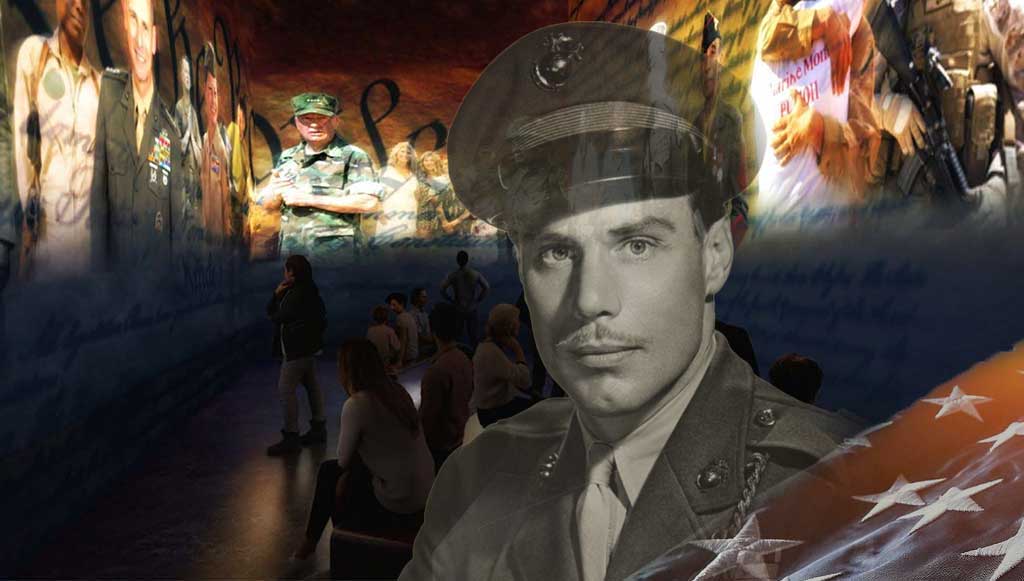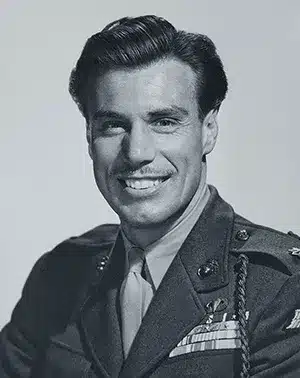Col Peter Ortiz

A recent issue of Chronicles: A Magazine of American Culture contains an article by historian and Marine Corps veteran Roger McGrath titled “The Marine Corps’ Answer to James Bond.” The article looks at the life and career of Col Peter Ortiz, who was born Pierre Julien Ortiz in New York City in 1913. His mother was an American of Swiss-German descent and his father was French. Ortiz grew up speaking English, French, and German, and later acquired fluency in Spanish and Arabic, and proficiency in Italian and Portuguese. After grammar school in America, Ortiz went to France to attend prep school and later college at the University of Grenoble. Bored and eager for adventure, Ortiz dropped out of college in 1932, after a year, and enlisted in the French Foreign Legion. Ortiz received basic training in Algeria and was then posted to Morocco as a corporal where he was in a number of battles with bandits and pirates of various kinds, was wounded in combat, and twice received the Croix de Guerre. At the end of his five-year enlistment, Ortiz had become commander of an armored car unit at the rank of brevet 2nd lieutenant.

Offered the rank of lieutenant if he’d stay in the Foreign Legion, Ortiz instead went to Hollywood where he was employed as a technical advisor on movies having a North African or military theme. When war began in 1939, Ortiz returned to France and re-joined the Foreign Legion at the rank of sergeant. Sgt Ortiz distinguished himself in combat and in May 1940 received a battlefield commission as a lieutenant for his leadership and courage. During a French retreat in 1940, Lt Ortiz learned that a fuel storage dump had not been burned. Ortiz sped to the fuel dump on a motorcycle and set it ablaze while under fire from German soldiers. He was wounded, shot in the hip, and captured. For this act of bravery, Lt Ortiz received a third Croix de Guerre.
Ortiz spent fifteen months in captivity in Germany, Poland, and Austria where he escaped in October 1941, arriving in Portugal in November. Both the Free French and the British operating in Portugal offered Ortiz a commission, but he chose instead to return to America to look after his sick mother.
Ortiz arrived in New York in early December of 1941, bound for California. While in New York, Ortiz was debriefed by Navy and Army intelligence officers, and also submitted paperwork for a commission in the American armed forces. Peter Ortiz was in California for several months without receiving a reply to his application for a commission, so he enlisted in the Marine Corps. At Parris Island, Private Ortiz made a significant impression on his drill instructors. The chief of staff at Parris Island, Col Louis Jones, sent a packet of materials to the Commandant of the Marine Corps including Ortiz’ application for a commission, the record of Ortiz’ service in the Foreign Legion, and a personal note saying:
“Private Ortiz has made an extremely favorable impression upon the undersigned. His knowledge of military matters is far beyond that of a normal recruit instructor. Ortiz is a very well set up man and makes an excellent appearance…. In my opinion he has the mental, moral, professional, and physical qualifications for the office for which he has made application.“
In August of 1942, Private Ortiz received a commission as a 2nd lieutenant in the Marine Corps. He remained at Parris Island for two months as an assistant training officer before going to Camp Lejeune for Parachute School.
Given Lt Ortiz’ experience and abilities, Headquarters Marine Corps decided to send him to the Army to participate in Operation Torch, landing on the beaches of Morocco and Algeria. Before leaving for North Africa, Lt Ortiz was promoted from 2nd lieutenant to captain, skipping 1st lieutenant. On December 21, Capt Ortiz flew to Tangier, Morocco under cover as an assistant naval attaché but with the mission of organizing and leading Arab tribesmen gathering intelligence behind German lines in Tunisia as part of an operation of the Office of Strategic Services (OSS). In January 1943, Ortiz and his men were on a reconnaissance patrol when they encountered German soldiers. In what was described as a “fierce firefight,” Ortiz, though wounded, continued throwing grenades at the Germans with such accuracy that they broke off the fight and withdrew. Capt Ortiz received a Purple Heart, and was assigned full time to the OSS.
After some time recuperating in Algiers and in Washington, D.C., Ortiz flew to London in July 1943 to train for a mission behind German lines in France. Ortiz’ mission was to parachute into the Haute Savoie region of southeastern France near the borders of Switzerland and Italy where there were large numbers of Free French partisans eager to fight the German Army. Ortiz was dispatched with a British agent and a French agent to organize fighters in the region and to lead them in raids on German soldiers, equipment, and generally to cause disruptions. The aim of the mission was to present difficulties for German commanders that would divert German forces and materiel to this region far from the coast ahead of the invasion of France on D-Day.
On the night of January 6, 1944, Capt Ortiz and his counter-parts parachuted onto the Vercors Plateau in southeastern France to conduct Operation Union. The three officers were dressed in civilian clothes, but carried uniforms with them in their packs. They moved quickly to contact the French partisans known as Maquis, and to organize them into fighting units. Capt Ortiz was conspicuous in showing himself to the local inhabitants so they’d know they were not alone. The British agent with him later said that Ortiz “did not hesitate to wear his U.S. Marine captain’s uniform in town and country alike; this cheered the French but alerted the Germans and the mission was constantly on the move.” Ortiz and the Maquis attacked German positions, destroyed supply stores, and stole German vehicles. German command was intent on catching the Marine and disbanding his men. One night, Ortiz entered a café where three German officers were planning his capture. He wore his uniform under a cape. Approaching the table where the officers sat, Ortiz threw back the cape and, drawing a pair of pistols from their holsters, gunned them down.
In May 1944, Capt Ortiz was extracted from France and flown to London where he was decorated with the Navy Cross, promoted to major, and prepared for a return to France for Operation Union 2. This time, Maj Ortiz would lead five enlisted Marines, an Air Force captain, and a French officer carrying documents that identified him as an American Marine. All of them wore uniforms. On August 1, 1944 Ortiz and his men parachuted from an American B-17 into the designated area in France. The parachute of one of the Marines did not open and he died upon hitting the ground. Within days, the remaining fighters were in heavy combat, and at one point they retreated into a steep-walled canyon and were trapped, surrounded by German soldiers. When night came, Maj Ortiz led his men out of the trap crawling silently through German lines. Not long after this, however, Ortiz and his men were surprised by a German armored column and compelled to surrender. Maj Ortiz ordered his men to say nothing but what was required by the Geneva Convention. They were taken north to a prisoner-of-war camp near Bremen on the North Sea. Ortiz was placed in a camp for captured officers whereupon he inquired about plans to escape. He was told there were no plans to escape, so Maj. Ortiz organized the American officers there to plan for a break-out.
On the night of December 18, Ortiz and an American Navy lieutenant managed to cut through the wire fences holding them in and run for the woods, but they were captured and placed in solitary confinement. On April 10, 1945, with Allied forces entering Germany, Ortiz and his fellow prisoners were moved to a camp about 120 miles to the northeast. Along the way, the column they were marching in was attacked by RAF Spitfires. In the confusion of the attack, Ortiz, with two Americans and an Englishman, fled into the woods undetected by German guards. Hoping to be rescued by Allied troops, the men saw only Germans, and after ten days without food, they returned to the abandoned camp where they had been held to look for food. When they entered the camp, the remaining German guards paid them no attention, but Ortiz was reunited with the Marines in is OSS group.
A week later, a British armored division arrived at the camp. As the remaining prisoners were boarding trucks for transportation to the rear, Ortiz asked if he and his men could join the British division. Later, he said of this request to fight with the British, “We Marines wanted to join this unit in order to bag a few more Germans before hunting season closed.” The request was denied. Ortiz was debriefed by an OSS officer and taken to the commander of the U.S. Navy’s 12th fleet who presented him with a second Navy Cross. With the war in Europe over, Ortiz asked for a combat assignment in the Pacific, and began preparing a team of men for an OSS mission in Indochina. However, the war ended before they were ready to deploy, and the team disbanded.
Ortiz returned to Hollywood to work as a technical advisor but upon meeting director John Ford, was offered a role in She Wore a Yellow Ribbon, starring John Wayne. In all, Peter Ortiz acted in 27 movies and two television series. In the movie Retreat, Hell!, about Marines in Korea, Ortiz played a Marine major. Peter Ortiz died in 1988 and was buried with military honors in Arlington National Cemetery. In attendance were his wife and his son, who was a Marine officer, and senior American and French officers. As Roger McGrath put it, “Peter Ortiz died a hero for two nations.”


